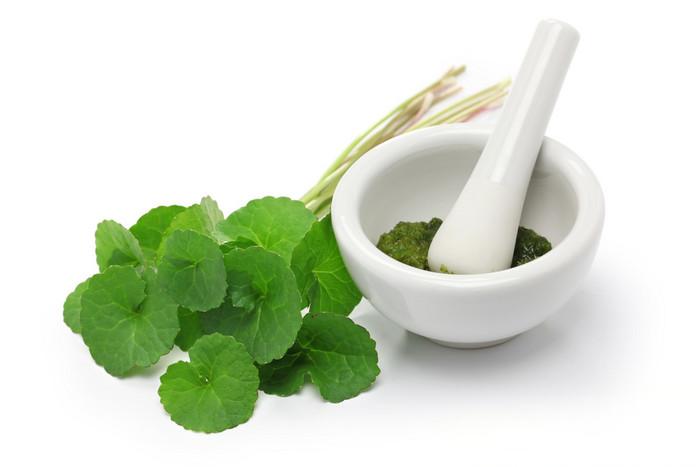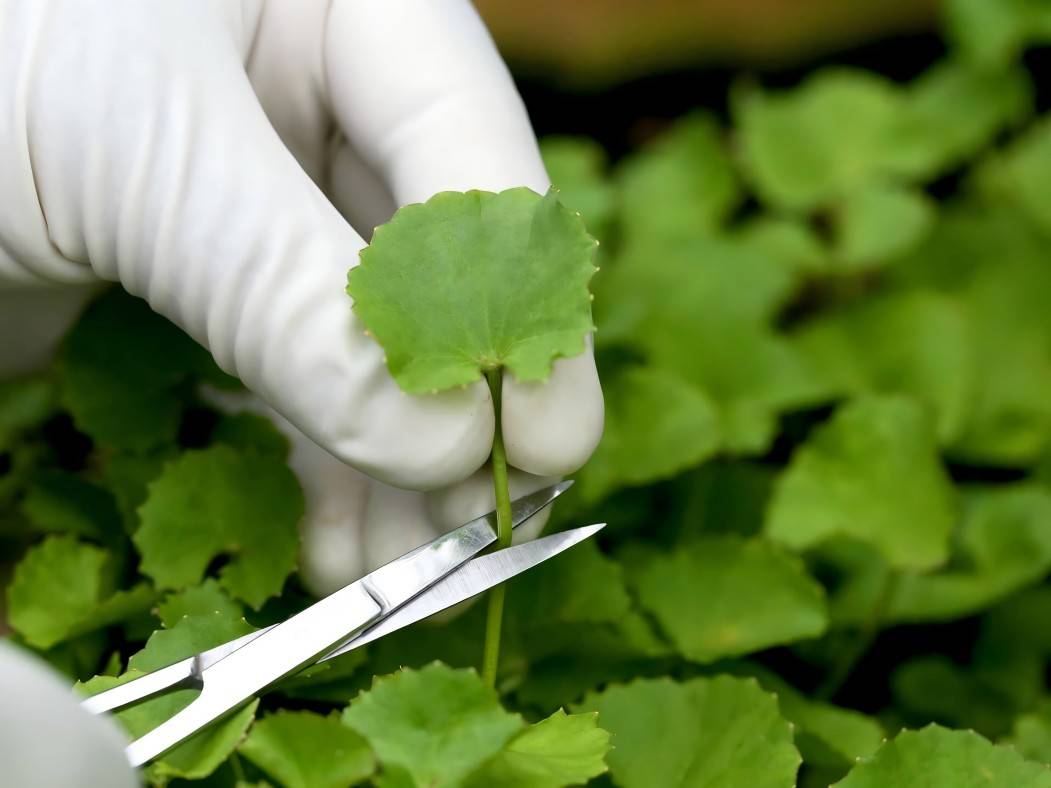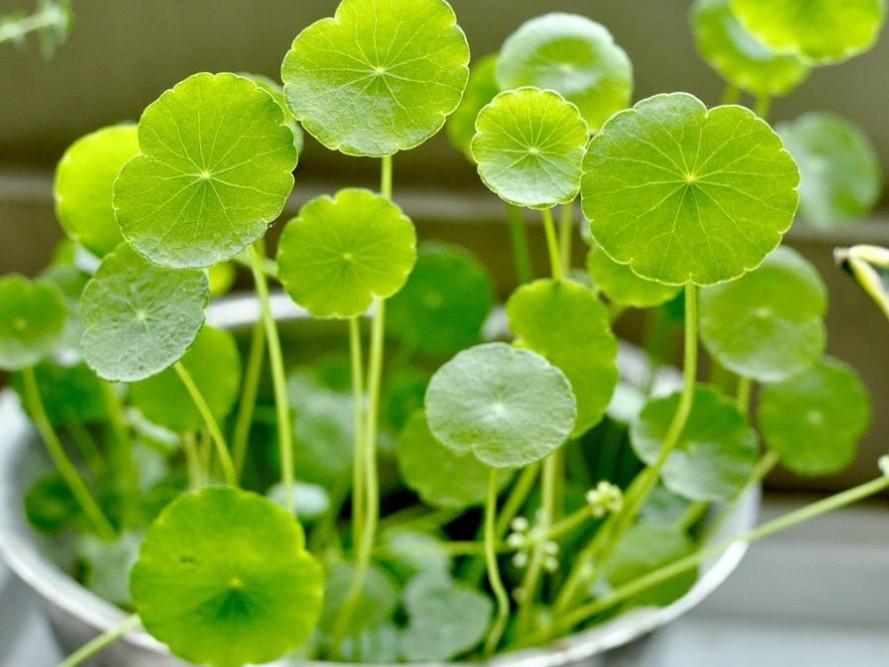What Is the Active Ingredient in Centella Asiatica Extract?
Centella asiatica (L.) Urb. is also known as horseshoe grass, copper grass, or crow's bowl. It is a perennial herb in the Apiaceae family that prefers shady, damp meadows or ditches. It is distributed in Shaanxi, Jiangsu, Anhui, and Zhejiang provinces in China, as well as in India, Sri Lanka, Malaysia, and Indonesia. Centella asiatica is cold in nature, bitter and pungent in flavor, and enters the liver, spleen and kidney meridians. It has the effects of clearing away heat and dampness, detoxifying and reducing swelling. It is mainly used to treat damp-heat jaundice, heatstroke diarrhea, stone dysuria, boils and sores, bruises and other injuries [1].
At present, research on the active ingredients and pharmacological effects of Centella asiatica extract has made great progress. It has been found that Centella asiatica contains various chemical components such as triterpene saponins, flavonoids, and essential oils, which have good medicinal effects on skin diseases, the nervous system, the digestive system, the respiratory system, and other diseases. However, at present, only the total amount of asiaticoside and madecassoside is used as an indicator of the quality of centella asiatica, which cannot fully reflect the correlation between the active substances in centella asiatica and the quality of the herb, and therefore has certain limitations.
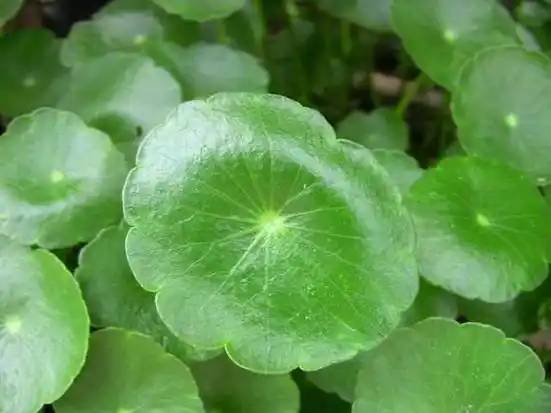
The concept of a quality marker (Q-Marker) for traditional Chinese medicine, proposed by Academician Liu Changxiao, can not only reflect this correlation, but also show the specificity and differential characteristics of the chemical composition of traditional Chinese medicine [2]. Therefore, this paper will review the chemical composition and pharmacological effects of Centella asiatica, predict and analyze its Q-Marker, promote the exploration and utilization of the medicinal value and clinical application of Centella asiatica, and provide a scientific basis for the quality control and standardization of Centella asiatica.
1 Active ingredients
The chemical composition of Centella asiatica extract is rich, mainly including triterpenoid saponins, flavonoids, essential oils and polyacenes. At present, researchers at home and abroad have conducted in-depth and extensive research on the triterpenoid saponins and pharmacological activities of Centella asiatica, followed by essential oils, while there are fewer reports on the polyacenes, flavonoids and other chemical components and their biological activities.
1. 1 Triterpenoid saponins
Triterpenoid saponins are a series of natural compounds with diverse structures formed by the condensation of a triterpenoid aglycone with one or more glycosyl and/or other chemical groups. According to the structure of the aglycone, most of the triterpene saponin components of Centella asiatica are pentacyclic triterpene saponins. The common structural types of pentacyclic triterpene saponins are oleanane type, ursane type, and lupane type, etc., and the structural types of Centella asiatica triterpene saponins are mainly the first two. Triterpene saponins are the main active ingredients of Centella asiatica. Among them, asiaticoside and madecassoside are the markers used to measure the quality of Centella asiatica in the 2020 edition of the Pharmacopoeia of the People's Republic of China, and the total amount is required to be not less than 0. 7% [1]. Some scholars comprehensively evaluated the quality of 29 batches of Centella asiatica from different origins and found that the content of asiaticoside was 0.383%–1.019%, and the content of madecassoside was 0.541%–1.915%. The quality of centella asiatica from Xiangjiang County, Ji'an City, Jiangxi Province was better [3]. The information on the triterpene saponins in Centella asiatica is shown in Table 1, and the structural formulas of the compounds are shown in Figure 1.
1. 2 Flavonoids
Li Jiaozhen et al. [19] detected 12 flavonoid compounds from Centella asiatica and compared their relative contents in the three parts of Centella asiatica: roots, stems and leaves. The results showed that the relative content of kaempferol, hyperoside and luteolin in Centella asiatica leaves was extremely higher than that in roots and stems, among which the relative content of kaempferol was the highest, followed by hyperoside. The chemical structure of the flavonoids in Centella asiatica is shown in Figure 2, and the compounds are shown in Table 2.
1. 3 Volatile oils
At present, a large number of volatile oil components have been isolated and identified from Centella asiatica, mainly terpenes, which can be subdivided into monoterpenes, sesquiterpenes and their oxygen-containing derivatives. Qin Luping et al. [22] used GC-MS to isolate and identify 45 volatile oil components from Centella asiatica, of which the higher content components are caryophyllene (19.35%, caryophyllene), farnesol (17. 66%, farnesol), 3-eicosyne (8. 06%, 3-eicosyne), β-elemene (4. 41%, β-elemene), longifolene (4. 20%, longifolene), etc., and confirmed the antidepressant effect of Centella asiatica volatile oil. Liang Jinyue et al. [23] identified 52 compounds from the volatile oil of Centella asiatica, the main components of which are pentacontane (18.18%, tetrapentacontane), ethyl palmitate (6.28%, ethyl palmitate), methyl palmitate (4. 29%, methyl palmitate), tetracosane (4. 15%, tetracosane), methyl oleate (2. 67%, methyl oleate), etc.
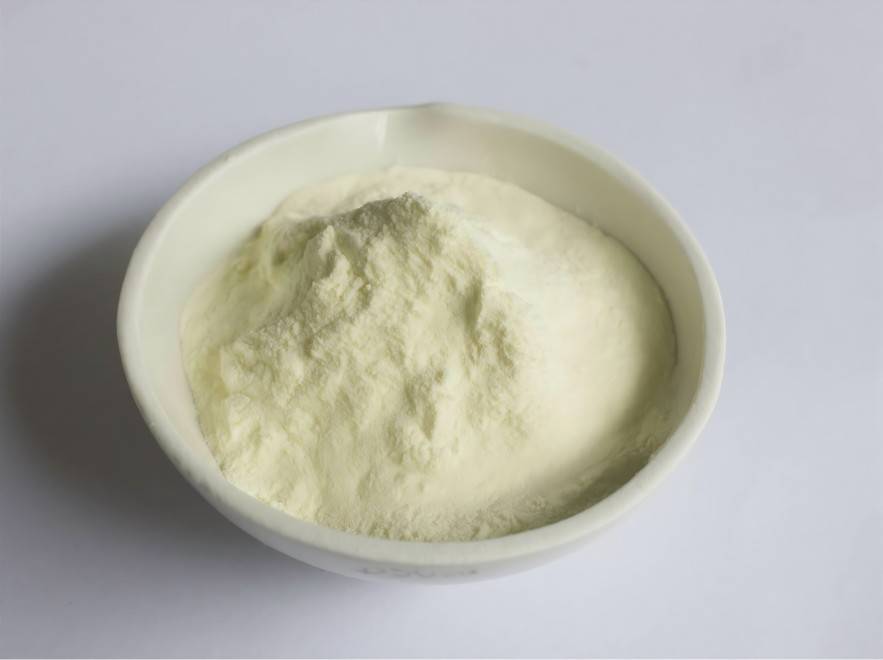
1. 4 Polyacetylenes
Centella asiatica extract also contains some polyacetylenes, but there have been relatively few studies on these components, and there is a relative lack of literature on their pharmacological activities. SCHULTE et al. [24] identified the structures of five of the isolated polyacetylenes from Centella asiatica, which are C16H21O2, C19H27O4, C19H27O4, C17H21O3 and C15H20O2. SIDDIQUI et al. [25] isolated and extracted the upper part of Centella asiatica to obtain three new compounds: centellin, asiaticin and centellicin. The structure has been determined by spectroscopic analysis. GOVINDAN et al. [26] isolated cadiyenol from the methanol extract of Centella asiatica. Another researcher [9] isolated two new polyacene compounds, C19H28O3 and C17H24O3, from Centella asiatica.
1. 5 Other chemical constituents
In addition to the above compounds, Centella asiatica extract also contains β-sitosterol, daucosterol, campesterol, steroid compounds such as castasterone, sitostenone, and other phenylpropanoid compounds such as chlorogenic acid, aromatic acid compounds such as vanillic acid, and essential trace elements such as Mn, Fe, Cu, Zn, Sr, Co, and Cr [21, 23, 27]. In addition, Centella asiatica contains polysaccharides and small amounts of vitamins, lignans, coumarins and other substances.
2 Pharmacological effects
Modern research has shown that Centella asiatica extract has pharmacological effects such as promoting wound healing and inhibiting scar hyperplasia, anti-Alzheimer's disease, and improving kidney and lung damage and arthritis. It is especially effective in treating inflammation and skin diseases. Centella asiatica is not only of high medicinal value, but can also be eaten as a wild vegetable. The “Compendium of Materia Medica” once mentioned that “people often eat it as lettuce.”
2.1 Promotes wound healing and inhibits scar hyperplasia
Studies have shown that the triterpenoid components of Centella asiatica extract have the effect of promoting wound healing. Hydroxy asiatic acid is one of the main active ingredients in Centella asiatica for the treatment of burns and scalds. its mechanism of action may be related to inhibiting lipid peroxidation, promoting collagen synthesis and inhibiting apoptosis [28]; while asiaticoside can promote wound healing by increasing the expression of cyclin B I and proliferating cell nuclear antigen PCNA, and inhibit the over-expression of the inflammatory response by inhibiting the nuclear transport of the main NF-κB subunit p65 protein [29]. Ouyang Danwei et al. [30] explored the pharmacological basis of Centella asiatica total saponins for inhibiting scar proliferation and found that madecassoside, asiatic acid, madecassoside and centellasaponin B can all inhibit the proliferation of scar fibroblasts and are more effective than Centella asiatica total saponins. In addition, hydrogels prepared from Centella asiatica and its active ingredient extracts have good healing effects and no significant skin toxicity [31].
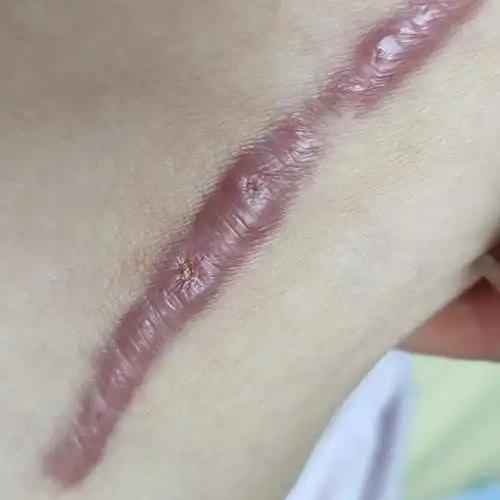
2. 2 Anti-Alzheimer's disease
Centella asiatica has a neuroprotective effect and can relieve many neurodegenerative diseases. One of the more widely studied is its effect against Alzheimer's disease (AD). FUJIMORI et al. [32] found that various compounds in Centella asiatica, such as madecassoside, asiaticoside, rutin, kaempferol, quercetin and its component araliadiol, have neuroprotective effects against oxidative stress and endoplasmic reticulum stress, and can prevent cognitive dysfunction. Most of the current research on the mechanism of Centella asiatica's anti-AD effect focuses on its triterpenoid components. Centella asiatica glycosides may alleviate Aβ1-42-induced cell apoptosis by inhibiting the TLR4/NF-κB signaling pathway, thereby improving AD symptoms [33]; and asiatic acid may reduce cognitive impairment and cholinergic deficits, which are pathological features of AD, by activating the Akt/GSK3β pathway, thereby exerting a neuroprotective effect [34].
2. 3 Improvement of kidney and lung damage and arthritis
Centella asiatica has a good ameliorative effect on kidney disease, especially chronic kidney disease. Centella asiatica glycosides can activate the SIRT1/FOXO3/PINK1/Parkin signaling pathway to improve mitochondrial autophagy in rats, or activate the Nrf2/HO-1 signaling pathway to regulate the downstream antioxidant enzyme superoxide dismutase to combat oxidative stress damage to cells, thereby exerting a protective effect on renal ischemia-reperfusion injury [35-36]. Centella asiatica can improve renal tissue damage by increasing antioxidant enzymes or regulating the TGF-β1/Smad signaling pathway in the prevention and treatment of early diabetic nephropathy [37-38].
Centella asiatica has also been shown to have a positive effect on lung function, which is closely related to its anti-pulmonary fibrosis and anti-inflammatory effects. Asiaticoside can reduce inflammatory cell infiltration and damage to the alveolar structure of the lungs by regulating the NLRP3/IL-1β/IL-18/TGF-β1 signaling pathway, thereby improving silicosis fibrosis [39]. And madecassoside has a protective effect on LPS-induced acute lung injury, and the mechanism may be related to reducing alveolar epithelial permeability and inflammatory response by inhibiting the activation of the TLR4/NF-κB pathway [40].
Centella asiatica plays an important role in the treatment of arthritis due to its anti-inflammatory and immunomodulatory activities. Studies have shown that madecassoside can inhibit cartilage cell-associated inflammation by regulating NF-κB signaling in vitro, and can reduce cartilage degeneration in vivo, suggesting its potential for the treatment of osteoarthritis [41]. And asiatic acid can regulate the p53-related pathway to induce apoptosis of rheumatoid arthritis fibroblast-like synoviocytes, and inhibit the proliferation and migration of RA-FLS through Nrf2/HO-1 regulation of NF-κB, thereby playing an anti-rheumatoid arthritis role [42].
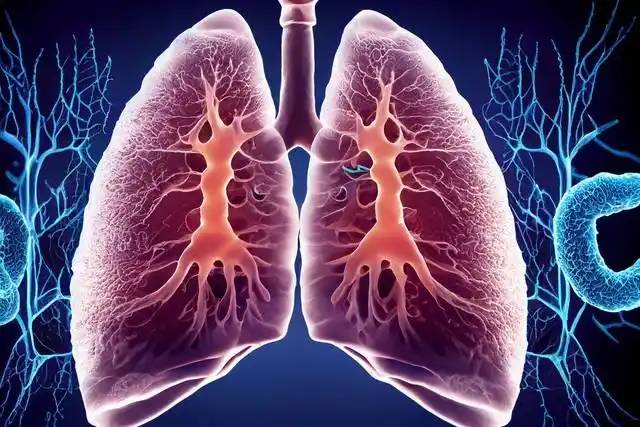
2. 4 Anti-tumor
Centella asiatica has a wide range of anti-tumor effects and can inhibit the growth of tumors such as liver cancer, breast cancer, and kidney cancer. Liu Chenxu et al. [43] found that asiaticoside can promote apoptosis of breast cancer MCF-7 cells and may inhibit breast cancer angiogenesis. Centella asiatica extract has a significant inhibitory effect on the proliferation of human liver cancer cell lines QGY-7703 and Bel-7402, and significantly antagonizes P-gp-mediated multidrug resistance in liver cancer cells [44].
Madecassoside can inhibit the proliferation and migration of colon cancer SW480/HCT116 cells by regulating the expression of Pdcd4 through the PI3K/Akt/mTOR/p70S6K pathway [45]. Research by Jing Yue [46] showed that the derivative AA-PMe of asiatic acid can effectively inhibit gastric cancer cell proliferation, induce apoptosis, migration and invasion, and has almost no toxicity to normal cells, and has great potential in the prevention and treatment of gastric cancer. By inhibiting the p-ERK/p-p38MAPK axis, asiatic acid inhibits the metastasis of renal cancer cells and can be used as a potential anti-renal cancer metastasis agent [47].
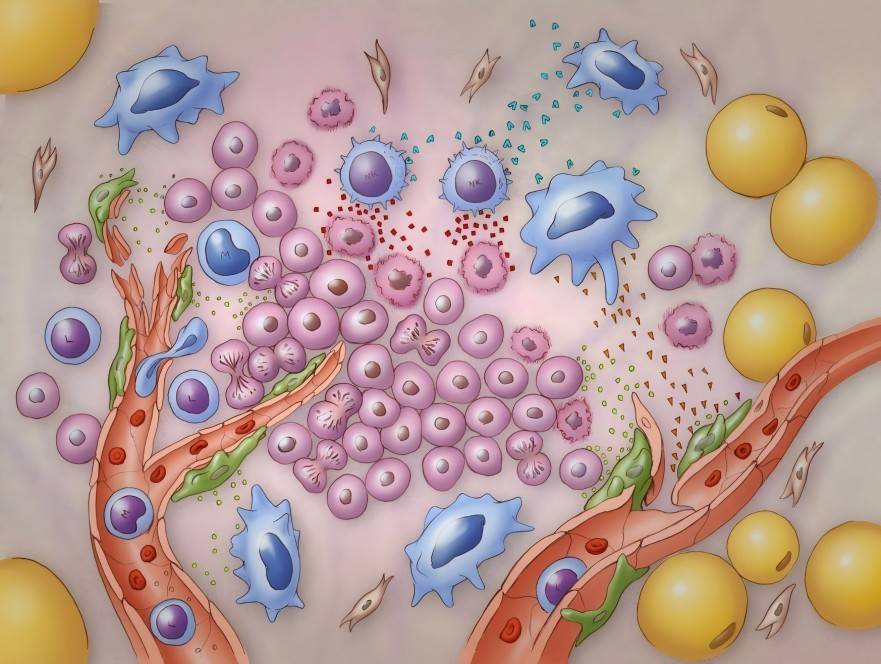
2. 5 Antidepressant and anxiolytic
Studies have shown that the anti-anxiety activity of Centella asiatica standard extract ECa233 may be achieved by activating AMPA receptors to excite synaptic GABAergic input ITC, resulting in inhibition of neurons in the central nucleus of the amygdala [48]. WANG et al. [49] used sucrose preference tests, forced swimming tests, and tail suspension tests to conduct behavioral tests on mice exposed to chronic unpredictable mild stress. Centella asiatica extract may play an important role in antidepressant activity by activating the cAMP/PKA signaling pathway. In addition, centella asiatica extract can also activate this signaling pathway to inhibit NF-κB and NLRP3-related inflammation, and has certain anti-inflammatory activity.
3 Q-Marker predictive analysis
Centella asiatica is rich in chemical components, widely distributed, and 90% of the supply comes from wild plants [50]. Affected by various factors such as ecological environment and processing methods, the types and contents of its chemical components are different, resulting in differences in the quality of the medicinal materials. Therefore, the author conducted a literature search and analysis to predict the Q-Marker of Centella asiatica, which is important for the further establishment of a scientific and complete quality control system for Centella asiatica. Since there are about 20 species of Centella asiatica in the world and only one species is produced in China, and the current research on the genus mainly focuses on Centella asiatica, the Q-Marker of Centella asiatica is not predicted from the perspective of plant phylogeny.
3.1 Q-Marker prediction analysis based on traditional medicinal properties
The theory of medicinal properties of traditional Chinese medicine is an important part of traditional Chinese medicine theory, which summarizes the laws and characteristics of the action of traditional Chinese medicine. It is closely related to the efficacy of traditional Chinese medicine and can be used as one of the bases for predicting Q-Markers. Bitter drugs “can purgative, drying, and hardening”, and have the effects of “releasing fire, lowering Qi, drying dampness, and strengthening Yin”. The main components can be roughly divided into three categories: alkaloids, glycosides, and bitter substances [51].
The pungent taste of the medicine “can move and disperse”, and has the effects of sweating, dispersing cold, resolving phlegm, and moving qi. The main active ingredients are volatile oils, glycosides, and alkaloids [52]. Centella asiatica is cold in nature, bitter and pungent in taste. According to its main chemical components, triterpenoid saponins and volatile oil components should be used as reference for Q-Marker. Centella asiatica belongs to the liver meridian. Studies have shown that Chinese herbal medicines belonging to the liver meridian have anti-inflammatory, antibacterial, antipyretic and analgesic pharmacological effects, which are mainly due to flavonoids, organic acids and terpene components [53]. Therefore, the triterpene saponins, essential oils and flavonoids in Centella asiatica can be used as the main substance basis of traditional medicinal properties and as a reference basis for Q-Markers.
3.2 Q-Marker prediction analysis based on traditional medicinal properties
Centella asiatica was first mentioned in Shennong's Classic of Materia Medica, which records that “Centella asiatica is bitter and cold in nature. It is mainly used for treating severe fever, malignant tumors, abscesses, boils, redness of the skin, and fever. The “Compendium of Materia Medica” states: “Crush it and apply it to all kinds of hot and poisonous abscesses, etc.” The “Minnan Materia Medica” records that Centella asiatica is used to treat summer heat, abdominal pain, and abdominal distension.
The 2020 edition of the “People's Republic of China Pharmacopoeia” records that Centella asiatica has the effects of clearing away heat and dampness, detoxification and swelling reduction effects, and is mainly used to treat damp-heat jaundice, heat stroke diarrhea, hematuria and hemoptysis, boils and sores, and bruises and other injuries [1]. It can be seen that Centella asiatica is mostly used to treat diseases caused by fire and damp-heat toxins, and is mainly used to treat fever, boils and sores, abdominal distension and abdominal pain. Modern research has proven that the triterpenoids in Centella asiatica have pharmacological effects such as anti-inflammatory, promoting wound healing, reduce skin inflammatory diseases, and improve liver, colon, and stomach-related digestive system diseases. The main active ingredients are asiaticoside, madecassoside, madecassic acid, and madecassoside acid [54]. These pharmacological activities are consistent with the traditional effects of Centella asiatica, so they should be the main options for Q-Marker screening.
3. 3 Q-Marker prediction analysis based on the assay of chemical constituents
“Assay” is one of the five elements of Q-Marker, which is a necessary condition for establishing quality evaluation methods and quality standards. It requires that the chemical constituents of traditional Chinese medicine can be qualitatively or quantitatively determined. Yan Kai et al. [55] simultaneously determined the contents of seven active ingredients in Centella asiatica (asperulosid B, asperulosid, asiaticosid, asperulosidic acid, as well as quercetin and kaempferol). ALQAHTANI et al. [56] used HPLC-DAD to quantitatively determine the eight components of Centella asiatica, including asiaticoside, madecassoside, asiatic acid, madecassic acid, rutin, quercetin, kaempferol and chlorogenic acid. Based on the predictability of chemical composition, the above Q-Markers can be included for reference, providing a theoretical basis for establishing a unique quality control system.
3. 4 Q-Marker prediction analysis based on the components expressed in different compound prescriptions
Centella asiatica is mostly used in compound prescriptions in clinical practice, playing a specific role in different prescriptions to achieve the desired effect. The compound Centella asiatica tonifies and replenishes the blood, dispels wind-dampness, and resolves stagnation. It has been used for many years to treat chronic kidney diseases such as IgA nephropathy, chronic glomerulonephritis, and diabetic nephropathy. Among them, Centella asiatica is the main herb, which has the effects of clearing away heat and dampness, detoxifying and reducing swelling, tonifying the kidney and resolving blood stasis [57-58]. Studies have found that asiaticoside and asiatic acid have a protective effect on acute kidney injury [59-60].
Although there are still relatively few reports on the pharmacological activities of flavonoids in centella asiatica, studies have shown that flavonoids such as quercetin, baicalein, luteolin, and kaempferol can alleviate diabetic nephropathy [61]. Therefore, the pharmacological activities of triterpene saponins, mainly asiaticoside and asiatic acid, and flavonoids such as quercetin, baicalein, luteolin, and kaempferol, are consistent with the specific effect of “tonifying the kidney and resolving stasis” in different compound compatibility environments. They are recommended as Q-Marker references for Centella asiatica compound.

4 Conclusion
Centella asiatica extract has complex active ingredients and a wide range of pharmacological activities, and has great application prospects in the pharmaceutical, cosmetics and health product industries. Domestic and foreign scholars have conducted in-depth research on it, but some questions remain. At present, there have been more reports on the triterpenoid saponin components of centella asiatica, but the pharmacological effects are mainly concentrated on asiaticoside, madecassoside, as well as asiatic acid and madecassic acid.
There have been relatively few studies on the activity of other triterpenoid saponins and major monomers. The demand for centella asiatica is constantly growing, and its source mainly depends on the wild, which has led to a shortage in some areas. Therefore, it is urgent to screen for superior germplasm and develop artificial cultivation techniques to ensure sustainable harvesting. In addition, centella asiatica has a wide distribution area, complex chemical composition, and different harvesting sources, its quality varies, which limits the clinical application of Centella asiatica and the development of related industries. Therefore, it is urgent to establish a scientific, effective, unique and systematic quality evaluation method.
This paper systematically reviews the chemical composition and pharmacological activity of Centella asiatica. Under the guidance of the basic theory of traditional Chinese medicine, the theory of quality markers in traditional Chinese medicine and modern pharmacological theory, Centella asiatica Q-Marker is analyzed and predicted from the perspectives of traditional medicinal properties, traditional medicinal effects, chemical composition measurability, the expression of components in different compound prescriptions, etc., to predict the analysis of Centella asiatica Q-Marker. It is suggested that triterpene saponins, mainly including asiaticoside, madecassoside, madecassic acid, asiatic acid and asiaticoside B, volatile oils, and flavonoids such as rutin, quercetin, flavonoids such as baicalein, quercetin,baicalin, luteolin and kaempferol are used as reference for the Centella asiatica Q-Marker. However, further research is needed on other related Q-Markers. It is hoped that this will provide a literature basis for the establishment of a scientific and comprehensive quality control system for Centella asiatica with strong specificity, and enhance the rational development and utilisation of Centella asiatica resources.
References
[1] National Pharmacopoeia Commission. Pharmacopoeia of the People's Republic of China [M]. Beijing: China Medical Science and Technology Press, 2020: 296.
[2] Liu Changxiao, Chen Shilin, Xiao Xiaohe, et al. Traditional Chinese medicine quality markers (Q-Marker): a new concept for the quality control of traditional Chinese medicine products [J]. Traditional Chinese Medicine, 2016, 47(9): 1443-1457.
[3] Liu Fusong, Li Yaoyao, Nie Xiuqiang, et al. Evaluation of the quality of Centella asiatica based on sensory characteristics combined with the grey relational degree method [J]. Chinese Journal of New Drugs, 2021, 30(20): 1881-1889.
[4 ] RUMALLA C S,ALI Z,WEERASOORIYA A D,et al. Two new triterpene glycosides from Centella asiatica[J]. Planta Medica,2010, 76( 10):1018-1021.
[5 ] MATSUDA H,MORIKAWA T,UEDA H,et al. Medicinal foodstuffs. XXVII. Saponin constituents of gotu kola( 2): structures of new ursane-and oleanane-type triterpene oligoglycosides,centellasaponins B,C,and D,from Centella asiatica cultivated in Sri Lanka[J]. Chemical and Pharmaceutical Bulletin,2001,49( 10):1368 -1371.
[6 ] CHIANESE G,MASI F,CICIA D,et al. Isomadecassoside,a new ursane-type triterpene glycoside from Centella asiatica leaves, reduces nitrite levels in LPS -stimulated macrophages [J]. Biomolecules,2021,11(4):494.
[7 ] WU Z W,LI W B,ZHOU J,et al. Oleanane - and ursane-type triterpene saponins from Centella asiatica exhibit neuroprotective effects[J]. Journal of Agricultural and Food Chemistry,2020, 68(26):6977-6986.
[8 ] SHAO Y,OUYANG D W,CHENG L,et al. New pentacyclic triterpenoids from Centella asiatica[J]. Helvetica Chimica Acta, 2015,98(5):683-690.
[9] Wang Yangyang. Extraction and separation of active ingredients in Centella asiatica [D]. Hangzhou: Zhejiang University, 2011: 3-10.
[ 10 ] SHAO Y,OUYANG D W,GAO W,et al. Three new pentacyclic triterpenoids from Centella asiatica[J]. Helvetica Chimica Acta, 2014,97(7):992-998.
[ 11 ] WENG X X,ZHANG J,GAO W,et al. Two new pentacyclic triterpenoids from Centella asiatica[J]. Helvetica Chimica Acta, 2012,95(2):255-260.
[ 12 ] JIANG Z Y,ZHANG X M,ZHOU J,et al. New triterpenoid glycosides from Centella asiatica[J]. Helvetica Chimica Acta,2005, 88(2):297 -303.
[ 13 ] NHIEM N X,TAI B H,QUANG T H,et al. A new ursane-type triterpenoid glycoside from Centella asiatica leaves modulates the production of nitric oxide and secretion of TNF - α in activated RAW 264. 7 cells[J]. Bioorganic & Medicinal Chemistry Letters, 2011,21(6):1777 -1781.
[ 14 ] REN B,LUO W,XIE M,et al. Two new triterpenoid saponins from Centella asiatica[J]. Phytochemistry Letters,2021,44:102 -105.
[ 15 ] YU Q L,DUAN H Q,GAO W Y,et al. A new triterpene and a saponin from Centella asiatica[J]. Chinese Chemical Letters,2007, 18( 1):62-64.
[ 16 ] YU Q L,DUAN H Q,TAKAISHI Y,et al. A novel triterpene from Centella asiatica[J]. Molecules,2006,11(9):661-665.
[ 17 ] JIAN P A N,GUIQING K A I,CHUANXUN Y,et al. Separation and determination of madecassic acid in extracts of Centella asiatica using high performance liquid chromatography with β - cyclodextrin as mobile phase additive[J]. Chinese Journal of Chromatography, 2007,25(3):316 -318.
[ 18 ] WENG X X,SHAO Y,CHEN Y Y,et al. Two new dammarane monodesmosides from Centella asiatica[J]. Journal of Asian Natural Products Research,2011,13(8):749-755.
[19] Li Jiaozhen, Sun Zhenghai, Cai Qichang, et al. Analysis of chemical constituents in different parts of Centella asiatica based on LC-MS [J]. Western Forestry Science, 2022, 51(4): 75-79, 86.
[20] SUBBAN R, VEERAKUMAR A, MANIMARAN R, et al. Two new flavonoids from Centella asiatica (Linn.) [J]. Journal of Natural Medicines, 2008, 62(3): 369-373.
[21] Duan Xiaoyan, Li Hongshu, Wang Lihong, et al. Research progress of Centella asiatica and its active ingredients at home and abroad [J]. Journal of Armed Police Medical College, 2009, 18 (3): 252-255.
[22] Qin Luping, Ding Ruxian, Zhang Weidong, et al. Analysis of the components of volatile oil from Centella asiatica and its anti-depression effect [J]. Journal of the Second Military Medical University, 1998, 19 (2): 186-187.
[23] Liang Jinyue, Li Yajuan, Liu Yue, et al. Neuroprotective effect and chemical composition of Centella asiatica volatile oil [J]. Journal of West China Pharmacy, 2022, 37 (1): 53-57.
[24 ] SCHULTE K E,RUECKER G,Bary E A. Polyacetylenes from Hydrocotyle asiatica L.[J]. Archiv der Pharmazie,1973,306(3): 197-209.
[25 ] SIDDIQUI B S,ASLAM H,ALI S T,et al. Chemical constituents of Centella asiatica[J]. Journal of Asian Natural Products Research, 2007,9(4):407-414.
[26 ] GOVINDAN G,SAMBANDAN T G,GOXINDAN M,et al. A bioactive polyacetylene compound isolated from Centella asiatica[J]. Planta Medica,2007,73(6):597-599.
[27 ] SONDHI N,BHARDWAJ R,KAUR S,et al. Inhibition of H2O2 - induced DNA damage in single cell gel electrophoresis assay(comet assay)by castasterone isolated from leaves of Centella asiatica[J]. Health,2010,2(6):595.
[28] Ouyang Shandan, Niu Chunyang. Protective effect of madecassoside on burn wound healing and endothelial cell damage [J]. Traditional Chinese Medicine, 2014, 37(4): 645-648.
[29] Wu Yanwen. Research on the mechanism of madecassoside in the treatment of burn wounds [D]. Nanjing: Nanjing University of Traditional Chinese Medicine, 2019: 3-10.
[30] Ouyang Danwei, Shao Yan, Kong Deyun, et al. Inhibitory effect of asiaticoside and its chemical constituents on the proliferation of scar fibroblasts [J]. World Clinical Drugs, 2014, 35(4): 215-220.
[31 ] LIU Y,ZHANG D,DENG J,et al. Preparation and safety evaluation of Centella asiatica total glycosides nitric oxide gel and its therapeutic effect on diabetic cutaneous ulcers[J]. Evidence -Based Complementary and Alternative Medicine,2022,2022:1419146.
[32 ] FUJIMORI H,OHBA T,MIKAMI M,et al. The protective effect of Centella asiatica and its constituent,araliadiol on neuronal cell damage and cognitive impairment[J]. Trends in Pharmacological Sciences,2022,148( 1):162 -171.
[33 ] SONG D Q,JIANG X,LIU Y L,et al. Asiaticoside attenuates cell growth inhibition and apoptosis induced by Aβ1-42 via inhibiting the TLR4/NF - κB signaling pathway in human brain microvascular endothelial cells[J]. Frontiers in Pharmacology,2018,9:28.
[34 ] RATHER M A,JUSTIN-THENMOZHI A,MANIVASAGAM T,et al. Asiatic acid attenuated aluminum chloride-induced Tau pathology , oxidative stress and apoptosis via AKT/GSK -3β signaling pathway in Wistar rats[J]. Neurotoxicity Reseach,2019, 35(4):955-968.
[35] Hu Yan, Wang Suogang, Zhai Qiongyao, et al. Research on the mechanism of asiaticoside regulating SIRT1-FOXO3-PINK1-Parkin pathway mediated mitochondrial autophagy to protect against renal ischemia-reperfusion injury [J]. Tianjin Medicine, 2021, 49(11): 1148-1153.
[36] Zhu Shiyu, Hu Yan, Wang Suogang, et al. Protective effect of asiaticoside on rats with renal ischemia-reperfusion injury [J]. Chinese Journal of Tissue Engineering Research, 2022, 26(23): 3609-3614.
[37] Ma Jiwei, Wang Hongtian, Liu Haofei, et al. Effects of Centella asiatica on TGF-β1 expression and related downstream signaling in early diabetic nephropathy rats [J]. Chinese Journal of Applied Physiology, 2018, 34(1): 69-73.
[38 ] SETYANINGSIH W A W,ARFIAN N,FITRIAWAN A S,et al. Ethanolic extract of Centella asiatica treatment in the early stage of hyperglycemia condition inhibits glomerular injury and vascular remodeling in diabetic rat model [J]. Evidence -Based Complementary and Alternative Medicine,2021,2021:6671130.
[39] Xing Chen, Yang Zhifeng, Li Ming, et al. Intervention effect of asiaticoside on the NLRP3/IL-1β/IL-18/TGF-β1 signaling pathway in rats with silicosis [J]. Chinese Journal of Industrial Medicine, 2022, 35(2): 115-118, 188, 193.
[40 ] PENG L Y,SHI H T,YUAN M,et al. Madecassoside protects against LPS-induced acute lung injury via inhibiting TLR4/NF - κB activation and blood-air barrier permeability[J]. Frontiers in Pharmacology,2020,11:807.
[41 ] MOQBEL S A A,HE Y,XU L,et al. Rat chondrocyte inflammation and osteoarthritis are ameliorated by madecassoside[J]. Oxidative Medicine and Cellular Longevity,2020,2020:7540197.
[42] Zhang L. Study on the effect and mechanism of asiatic acid on the growth and migration of rheumatoid arthritis fibroblast-like synoviocytes [D]. Jinzhou: Jinzhou Medical University, 2020: 3-10.
[43] Liu Chenxu, Qin Sida, Xu Tao, et al. Effects of asiaticoside on apoptosis and VEGF and bFGF protein expression levels in breast cancer MCF-7 cells [J]. Advances in Modern Biomedicine, 2018, 18(7): 1314-1317.
[44 ] MA Y,WEN J,WANG J,et al. Asiaticoside antagonizes proliferation and chemotherapeutic drug resistance in hepatocellular carcinoma (HCC )cells[J]. Medical Science Monitor:International Medical Journal of Experimental and Clinical Research,2020,26:e924435.
[45] Hao Yajuan. Research on the mechanism of asiatic acid regulating Pdcd4 to induce apoptosis in colon cancer SW480/HCT116 cells through the PI3K/Akt/mTOR/p70S6K signaling pathway [D]. Guangzhou: Southern Medical University, 2016: 4-20.
[46] Jing Yue. Synthesis, anti-tumor activity and mechanism of asiatic acid derivatives [D]. Nanjing: Nanjing Normal University, 2015: 4-20.
[47 ] HUANG C F,HUNG T W,YANG S F,et al. Asiatic acid from Centella asiatica exert anti-invasive ability in human renal cancer cells by modulation of ERK/p38MAPK-mediated MMP15 expression[J]. Phytomedicine,2022,100:154036.
[48 ] WANASUNTRONWONG A,WANAKHACHORNKRAI O,PHONGPHANPHANEE P,et al. Modulation of neuronal activity on intercalated neurons of amygdala might underlie anxiolytic activity of a standardized extract of Centella asiatica ECa233[J]. Evidence - based Complementary and Alternative Medicine ,2018 ,2018: 3853147.
[49 ] WANG L ,GUO T ,GUO Y ,et al. Asiaticoside produces an antidepressant-like effect in a chronic unpredictable mild stress model of depression in mice,involving reversion of inflammation and the PKA/pCREB/BDNF signaling pathway[J]. Molecular Medicine Reports,2020,22(3):2364-2372.
[50 ] IDRIS F N ,NADZIR M M. Comparative studies on different extraction methods of Centella asiatica and extracts bioactive compounds effects on antimicrobial activities[J]. Antibiotics - Basel,2021,10(4):457.
[51] Lv Jiahua, Zhu Chan, Tang Zongxiang. The formation mechanism and biological significance of “bitterness” in the medicinal properties of traditional Chinese medicine [J]. Journal of Guangxi Normal University (Natural Science Edition), 2022, 40(5): 324-331.
[52] Zhang M, Huo H, Wang P, et al. The origin of the theory of pungent properties and a review of modern research [J]. Chinese Herbal Medicine, 2018, 49(3): 505-511.
[53] Wang Xiaoxue, Lu Shan, Zheng Siyue, et al. Empirical analysis of chemical composition, pharmacological action and clinical application of Chinese medicinal herbs that return to the channels [J]. Chinese Journal of Traditional Chinese Medicine, 2018, 33(11): 5193-5197.
[54] SUN B, WU L, WU Y, et al. Therapeutic potential of Centella asiatica and its triterpenes: a review [J]. Frontiers in Pharmacology, 2020, 11: 568032. [55] YAN K, XU YM, XU JP, et al. Determination of the content of seven active ingredients in Centella asiatica by UPLC-MS/MS [J]. Chinese Journal of Clinical Pharmacology, 2017, 33 (19): 1949-1953.
[56] ALQAHTANI A, TONGKAO-ON W, LI K M, et al. Seasonal variation of triterpenes and phenolic compounds in Australian Centella asiatica (L.) Urb [J]. Phytochemical Analysis, 2015, 26(6): 436-443.
[57] Chen Xiao, Chen Hongyu. The compatibility of the formula of the compound Centella asiatica mixture and its application in IgA nephropathy. Journal of Jiangxi University of Traditional Chinese Medicine, 2015, 27(4): 118-121.
[58] Zhu Mengjie, Bao Ziyang, Yu Liqiang, et al. Clinical study on modified compound centellae asiatica decoction for treating chronic glomerulonephritis and chronic kidney disease stage 3 [J]. New Chinese Medicine, 2019, 51(11): 128-131.
[59] TANG S J,XIE X C,WANG M,et al. Protective effects of asiaticoside on renal ischemia reperfusion injury in vivo and in vitro[J]. Bioengineered,2022,13(4):10235 -10243.
[60 ] QIU W,ZHANG X,PANG X,et al. Asiatic acid alleviates LPS - induced acute kidney injury in broilers by inhibiting oxidative stress and ferroptosis via activation of the Nrf2 pathway[J]. Food and Chemical Toxicology,2022,170:113468.
[61 ] HU Q,QU C,XIAO X,et al. Flavonoids on diabetic nephropathy: advances and therapeutic opportunities[J]. Chinese Medicine,2021, 16( 1):1 -17.


 English
English French
French Spanish
Spanish Russian
Russian Korean
Korean Japanese
Japanese